Yesterday, AFC staff headed out to the New Museum for 1993, their first large-scale exhibition of the year. A full-length review for The L Magazine is in the works, but until then, here’s our commentary on the show’s hits and misses.

Felix Gonzalez-Torres, "Untitled (Couple)", 1993 (foreground); Felix Gonzalez-Torres, "Untitled", 1992-93 (background); Rudolf Stingel, "Untitled", 1991/2012 (on the ground).
The New Museum’s 4th floor gallery looks incredible. We doubted that mixing Stingel’s rec-room orange carpet with Gonzalez-Torres’s reverent lightbulb portrait would be a good idea, but it works. The entire room feels spiritual; it’s like walking into an art cathedral, if there were such a thing.
On a scale of one-to-creepy, Charles Ray’s nude nuclear family scores all the way to freakshow.

From left to right: Nayland Blake, "Equipment for a Shameful Epic," 1993; Sarah Lucas, "Self Portrait #3," 1993.
Sarah Lucas’s gender-bending dress up goes well with Nayland Blake’s costumes for the imaginary screenplay Asses Together.

Detail from Nayland Blake's closet of costumes and curiosities, "Equipment for a Shameful Epic," 1993.
Ah, yes…a time before we outsmarted fun. Never quit, Nayland Blake.
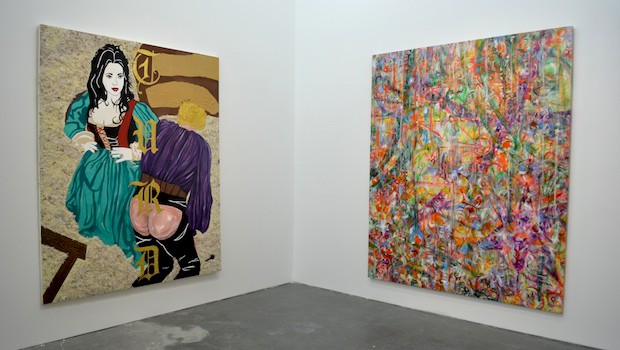
From left to right: Kathe Burkhart, "Turd," from "The Liz Taylor Series (Taming of the Shrew)", 1993; Jutta Koether, "Antibody IV (All Purpose Substance), 1993.
1993 was short on painting, and the painting’s that did make the cut weren’t always great. Case in point: Kathe Burkhart’s heavy-handed, pun-filled Liz Taylor painting.
This work is a good antidote to the Dieter Roth chocolate towers up at Hauser and Wirth right now, which much to the chagrin of the artist we’re sure, functions most clearly as a commodity. A bunch of self portrait busts with their face licked off don’t create quite the same effect.
In one of the signature works of the time, Pepon Osorio took a scene out of the South Bronx and brought it to the politically and racially charged 1993 Whitney Biennial. It hasn’t happened since.
David Hammons’ “In the Hood” automatically brings up the Trayvon Martin trial, coming up this June. Coincidence?
Fuck values.
A fun ride, or mortal danger? Again, gender politics come to the fore in Sarah Lucas’ work.
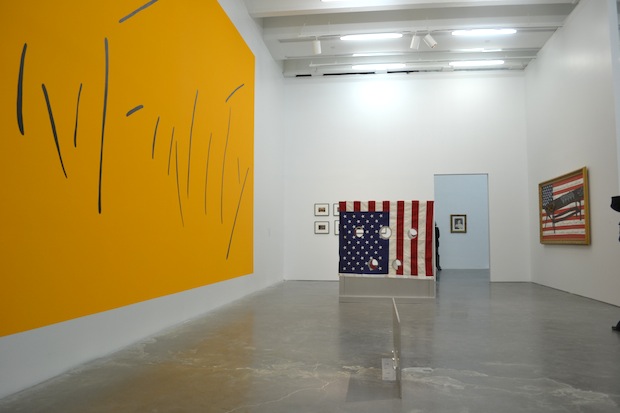
From left to right: Jessica Diamond, "Tributes to Kusama: Infinity", 1992/93; Cady Noland, "Gibbet", 1993/94; Kathe Burkhart, "Bill (The Luck)", 1978.
Rhodes’s installation included a calendar from the year 1993. Many of the works in 1993 featured an array of scattered, cast-off detritus, and Rhodes’s was no different. His work included a mess of items like silver pizzas, scrap wood panelling, and a calendar from the year 1993.

Ann Hamilton, "tropos", 1993 (foreground); Andres Serrano, "AIDS Related Death" and "Rat Poison Suicide II", 1992 (background).
Up until this show, I hadn’t seen an Andres Serrano piece I liked. His morgue series has all the shock he’s spent the last 20 years searching for and a little less spectacle. It’s fantastic work.
I was kinda pissed to see Donald Moffett and Marlene McCarthy’s poster “In Honor of Allen R. Schindler” shoved in the gratuity closet with Cindy Sherman’s mannequins and Alix Lambert’s wedding photo with Bob Nickas. They’re all great works, but have very little to do with each other; as such, they’re seen as islands. Maybe there just wasn’t enough space to deal with these works, but this is one of few works that appeared throughout New York City and spoke directly to the public.
Schindler was allegedly murdered by a fellow naval officer because he was gay, and he became a symbol for LGBT activist groups. Bureau’s poster of him was censored in Times Square, which says a lot more about the cultural tone than most art in the show.
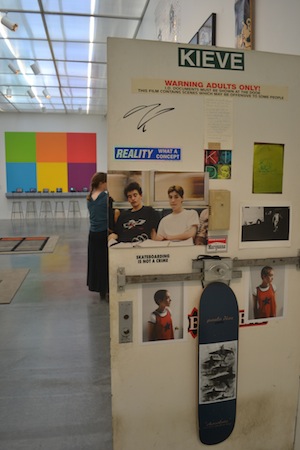
Lobby Gallery installation view: Larry Clark, "1993 Wall Piece", 2013 (foreground); Renée Green, "Early Videos", 1991-96 (background).
Two years prior to producing the acclaimed film Kids, Larry Clark was displaying wall photographs with skateboards. No real deep thoughts to offer here.
Hundreds of dirty abandoned strollers fill a warehouse space adjacent to the New Museum, while “Amazing Grace” plays overhead. I immediately thought of the pillars lined with soiled wheelchairs, crutches, and casts in Quebec’s Church of Miracles when I saw the piece; the supports belonged to crippled visitors who claimed to be healed after visiting the Church.
The connections I was making were mostly aesthetic, though as it happens Ward originally wanted to show the piece in a church, because he felt the location was life-affirming. In 1993, Nari Ward told The New York Times that he thought the strollers suggested a “banding together against abandonment, and in that unity, hope.”
I wish I shared that sentiment. Listening to “Amazing Grace” always makes me a little depressed—I don’t love being reminded of depravity, even if the end goal is to produce a more uplifting message—so its hard for me to look beyond the emptiness of those strollers. I noticed the grubby fire-hose binding the strollers together halfway through, and they looked like they were being strangled. (Paddy Johnson)
“NYC 1993: Experimental Jet Set, Trash, and No Star” is curated by Massimiliano Gioni, Associate Director and Director of Exhibitions, Gary Carrion-Murayari, Curator, Jenny Moore, Associate Curator, and Margot Norton, Assistant Curator.




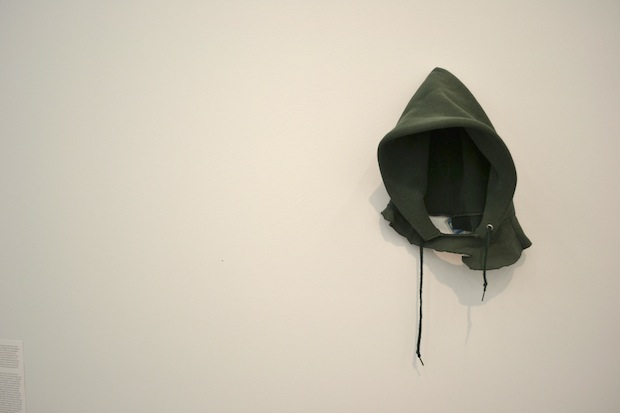
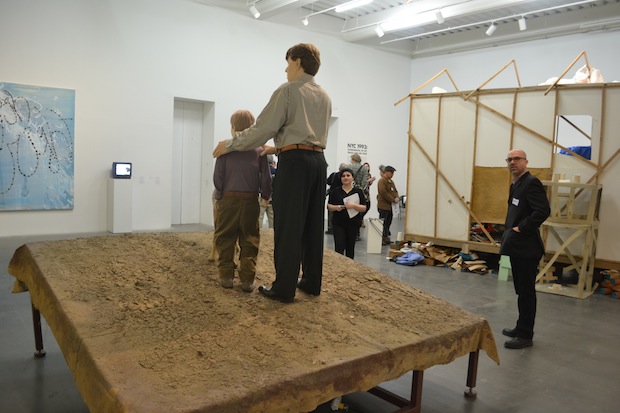

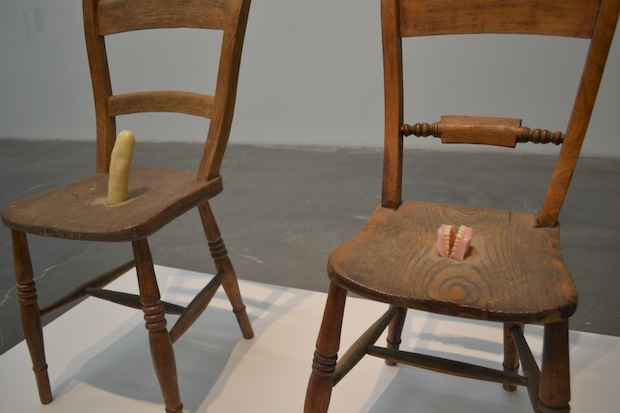

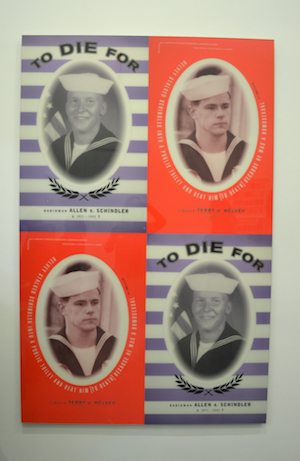
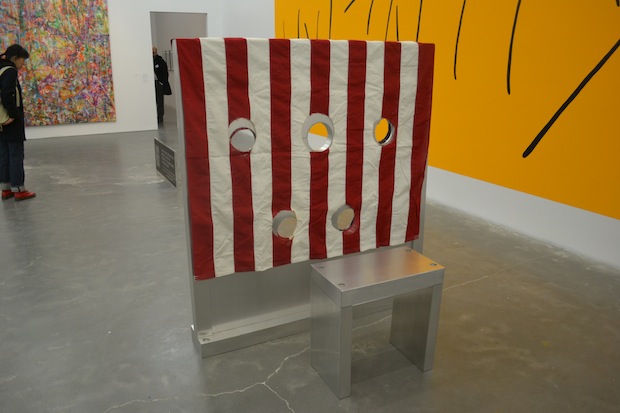


{ 2 comments }
maybe Massimiliano Gioni should take some time off from curating and listening to sonic youth.
The repetitive predictability of his shows is wearing thin and thinner.
While he is on a curatorial hiatus tell oneself “you don’t know what you don’t know”.
Thanks for posting so many photographs of the exhibition! Always helpful for those of us who can’t make it to New York to see the show.
Comments on this entry are closed.